RESULTS OF CLIMATE CHANGE
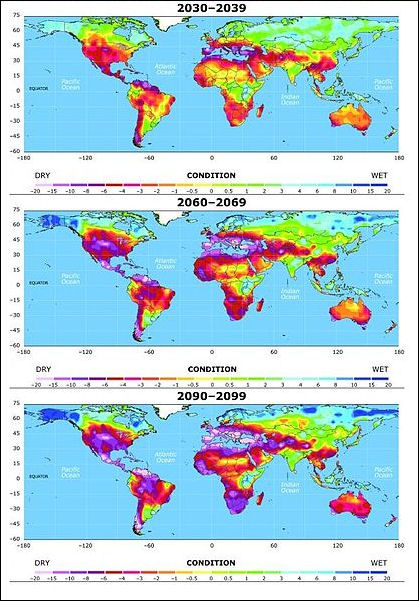
Drought Maps Manish Bapna and Jennifer Morgan wrote in the Washington Post, “Arctic sea ice, Greenland’s ice sheet, and glaciers in the Alps and the Antarctic Peninsula are all melting faster. The oceans have become more acidic as a result of the buildup of greenhouse gases, and the warming of rivers and lakes is affecting freshwater fish and other species. As are result, animals and plants are migrating toward poles or higher elevations in search of more hospitable habitats.” All these things have been blamed on climate change.
Among the climate-change-related things that worry scientists the most are: 1) the collapse of the Atlantic “conveyor belt — current; 2) the disintegration of the Greenland ice sheet; 3) climatic-change-induced ozone-hole deterioration; 4) massive methane release from beneath the tundra; 5) transformation of Saharan and Sahel vegetation; 6) disruption of the Indian monsoon; 7) erosion of the Himalayan and Tibetan plateau snow cover; 8) major shifts of the El Niño weather pattern; 9) collapse of the Amazonian rain forest; and 10) disintegration of the West Antarctic ice sheet.
A report released by the National Center for Atmospheric Research in Washington in 2006 predicted severe extended droughts in Brazil and the western United States and changes in ocean currents in the Atlantic that could reek havoc on the Mediterranean as a result of climate change. An IPCC report in 2006 said the Earth will warm by three degree C by 2050 and that increase could cause drought and famine for 400 million people. Scientist say that widespread coral bleaching related to climate change could occur within three decades; dramatic sea level changes could occur by 2100 and major changes in the oceans currents could happen by 2200.
“Tipping point” is a commonly used term to describe sudden, catastrophic changes that could have a profound impact on the globe or certain regions and might be difficult or impossible to reverse once they begin taking effect. Scientist say we are getting close but haven’t yet reached the tipping point of irreversible change caused by climate change.
Positive Effects of Climate Change?
Aryn Baker wrote in Time magazine: “Climate change has its winners and losers. As global temperatures rise, some species will find themselves squeezed out of suitable living arrangements while others—for a while at least—will see new opportunities opening up. The same goes for what we eat and drink. A study published in the scientific journal PLOS One in January 2022 suggest that some agricultural areas will see a decline of productivity as a result of global warming while others could see an increase. [Source: Aryn Baker, Time, January 27, 2022]
Pretty soon the ice-clogged Northwest Passage will be ice free. This could make shipping easier; improve access to offshore oil and gas sources on the continental shelves in the Arctic; and allow the exploitation of new fisheries in the open sea. Tankers that are too large to go through the Panama Canal could save large time and money by traveling through the same Northwest Passage that left many ice-trapped men dead in the 19th century. The increase in human traffic could also result in more wear and tear on the Arctic ecosystem. U.S. President Donald’s effort to buy Greenland from Denmark seemed to be an attempt to exploit future resource there.
In response to the question “Are there any positive effects of climate change?,” Matt McGrath of the BBC said: “There may well be some short-lived positive impacts to warming, but climate scientists have been quick to shoot them down because they are overwhelmingly outweighed by the negatives. The most widely quoted "benefit" is the idea that a world with higher carbon levels will see plants grow faster and bigger. This is called the CO2 fertilisation effect. However, research published in 2020 suggested that this effect is already waning and any idea that it could somehow limit future warming is not supported by the evidence. [Source: Matt McGrath, BBC, November 1, 2021]
Stern’s Analysis of Climate Change Results
Sir Nicholas Stern, the former chief economist at the World Bank, made a chart that outlined what might happen under different levels of temperature change. If the temperature rises 1 degree C Stern predicts then: 1) glaciers in the Andes might disappear affecting the drinking water of 50 million people; 2) cereal yields might rise in temperate regions; 3) at least 300,000 additional people might die from diseases like malaria; 4) thawing in Canada and Russia will damages roads and building; 5) 80 percent of coral might become bleached and 10 percent of land species face extinction; and 6) Atlantic thermohaline circulation weakens.
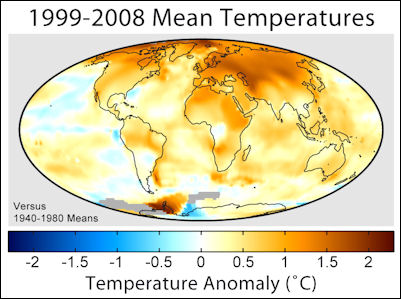
Global_Warming_Map If the temperature rises 2 degree C then: 1) 20 to 30 percent less water will be available in the southern Africa and the Mediterranean; 2) crop yields will drop in tropical regions; 3) up to 60 million more Africans will be exposed to malaria ;4) coastal flooding affects 10 million people a year; 5) 15 to 40 percent of species face extinction with those in the northern latitudes facing the greatest threat; 6) the Greenland ice sheet might start melting irreversibly, raising sea levels by seven meters.
If the temperature rises 3 degree C then: 1) there might be serious droughts in southern Europe nd elsewhere, with 4 billion people facing shortages; 2) more than a half billion more people will go hungry; 3) an additional 3 million would die from malnutrition; 4) coastal flooding would affect 170 million more people a year; 5) 20 to 50 percent of species face extinction; 6) the Amazon rain forest begins to die; and 6) severe atmospheric change occures.
If the temperature rises 4 degree C then: 1) up to 50 percent less water is available in southern Africa and the Mediterranean; 2) agriculture stops in Australia and decreases 35 percent less in Africa; 3) up to 80 million more Africans would be exposed to malaria ;4) coastal flooding affects 300 million people a year; 5) half the Arctic tundra disappears and half the world’s nature reserves can not fulfil their objectives; and 6) the West Antarctic ice sheet threatens to collapse.
If the temperature rises 5 degree C then: 1) glaciers in the Himalayas might disappear affecting the drinking water of hundreds of million people in China and India; 2) ocean acidity disrupts marine ecosystems and possibly fish stocks; 3) large cities such as New York, Tokyo, and London are low-lying coastal areas such as Bangladesh and Florida threatened by rising sea levels; and 4) circulation of water in the Atlantic stops.
Changing Ocean and Wind Currents
One of the most potentially dangerous consequences of all is the changing of ocean currents and wind patterns, which play an important roll bringing food, warmth and rain to Europe and other places. As the El Niño phenomena has shown ocean currents and wind patterns are vulnerable to temperature changes. In the past ocean currents have changed direction and had profound consequence son land masses.
An expedition off Antarctica found that deep water there has become cooler and less salty, raising concerns that deep ocean currents there are already slowing down, possibly throwing currents there out of wack in the future.
An important wind circulation pattern over the Pacific is weakening because of climate change. A study by Gabriel Vecchi of Princeton published in Nature said the so called Walker circulation pattern — a huge wind pattern that covers almost half the circumference of the Earth — has weakened by about 3.5 percent since the mid-1800s.The Walker circulation pattern is a big loop that begins with the trade winds blowing near the surface across the Pacific from east to west. The air rises in the western Pacific and then returns eastward at an altitude a of a few kilometers, then it sinks back again to the surface and starts the loop again.
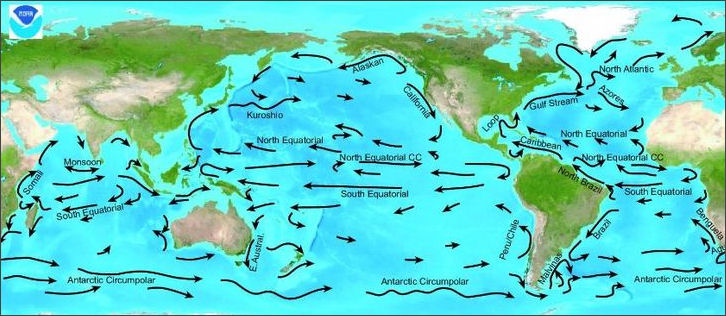
Ocean surface currents
Gulf Stream and of the Global Ocean Conveyor Belt
Many worry that the Atlantic thermhaline circulation that brings warm water to Europe as part of a conveyor-belt-like system will collapse. The Gulf Stream begins in the Gulf of Mexico and carries warm water to the North Atlantic. As it flows northward it breaks in two with one current flowing towards Africa while the other flows towards northern Europe. By the time the northen current reached the Arctic the waters have become colder and more saline, causing them to sink. A deep sea current of cold water flows back towards the Gulf of Mexico, completing the conveyor-belt-like system.
Jeff Berardelli of CBS News wrote: “Because the equator receives a lot more direct sunlight than the colder poles, heat builds up in the tropics. In an effort to reach balance, the Earth sends this heat northward from the tropics and sends cold south from the poles. This is what causes the wind to blow and storms to form. The majority of that heat is redistributed by the atmosphere. But the rest is more slowly moved by the oceans in what is called the Global Ocean Conveyor Belt — a worldwide system of currents connecting the world's oceans, moving in all different directions horizontally and vertically.[Source: Jeff Berardelli, CBS News, February 26, 2021]
“Through years of scientific research it has become clear that the Atlantic portion of the conveyor belt — the AMOC (Atlantic meridional overturning circulation) — is the engine that drives its operation. It moves water at 100 times the flow of the Amazon river. Here's how it works. A narrow band of warm, salty water in the tropics near Florida — the Gulf Stream — is carried northward near the surface into the North Atlantic. When it reaches the Greenland region, it cools sufficiently enough to become more dense and heavier than the surrounding waters, at which point it sinks. That cold water is then carried southward in deep water currents.
“Through proxy records like ocean sediment cores, which allow scientists to reconstruct the distant past going back millions of years, scientists know that this current has the capacity to slow and stop, and when it does the climate in the Northern Hemisphere can change quickly. One important mechanism through the ages, which acts as a lever of sorts controlling the speed of the AMOC, is the melting of glacial ice and resulting influx of fresh water into the North Atlantic. That's because fresh water is less salty, and therefore less dense, than sea water, and it does not sink as readily. Too much fresh water means the conveyor belt loses the sinking part of its engine and thus loses its momentum.
Effect of Climate Change on the Gulf Stream
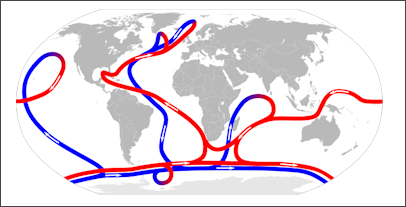
Thermohaline circulationIn one worst case scenario fresh water from melting ice in Greenland could send a sudden flow of freshwater into the North Atlantic, lowering the salinity of the water there and preventing the water there from sinking and disrupting the whole conveyor-belt system. If the system were to collapse the temperatures in Europe and North America would be significantly colder.
At the end of the last Ice Age, 14,000 years ago, the Gulf Stream was temporarily blocked and temperatures in Europe fell by as much 10 degrees F. Some experts say there is a 50-50 chance that the the Gulf Stream will collapse if temperatures rise above 5 degrees C in 2100. According to one study released in 2005 the Gulf Stream continues to move normally but the southward-flowing deep water counter current’s has weakened 30 percent in 12 years while the flow of warm water to Africa has increased by 30 percent .All this happening at a rate much faster than anyone thought possible.
In ancient time the conveyor belt currents have slowed and even stopped, producing a series of events that led to warmer temperatures in the Southern Hemisphere and colder ones in the Northern Hemisphere. When the Gulf Stream slowed Ireland and Britain were like Alaska.
Research in the fiords of Greenland by Woods Hole Oceanic Institute indicates that warm water from subtropical areas, carried north by the western branch of The Gulf Stream, is making its way to the Arctic and the warmer water may be contributing to the rapid advancement of Greenland’s glaciers.
Is the Gulf Stream Is Weakening?
There some danger of an Atlantic Thermohaline Circulation Collapse — a collapse of the Gulf Stream and AMOC system. There are indications the system has experienced a gradual weakening over the past few decades, and it may be critically unstable. Research by Timothy Lenton, chair of climate change and Earth system science at the University of Exeter, United Kingdom, suggests that if global temperatures continue to rise, the AMOC could collapse in 50 to 250 years. The 2019 IPCC report suggested the AMOC will “very likely” weaken in the 21st century but has a less than 10 percent chance of collapsing. But just the loss of a constant river of warmer water flowing toward Europe could lower temperatures there, strengthen hurricanes and raise the sea level along the northeastern coast of North America. “You’re not transporting as much water, so it gets backed up along the East Coast,” Dutton said. [Source: Elizabeth Weise, USA Today, April 7, 2022]
A study published in the journal Nature Geoscience in February 2021 said the Gulf Stream and AMOC is now moving more slowly than it has in at least 1,600 years. Scientists believe that at least part of this slowing is directly related to climate changer and the impact of melting ice on northern waters systems. Jeff Berardelli of CBS News wrote: ““Recent research has shown that the circulation has slowed down by at least 15 percent since 1950. Scientists in the new study say the weakening of the current is "unprecedented in the past millennium." by the end of the century it is estimated the circulation may slow by 34 percent to 45 percent if we continue to heat the planet. Scientists fear that kind of slowdown would put us dangerously close to tipping points. [Source: Jeff Berardelli, CBS News, February 26, 2021]
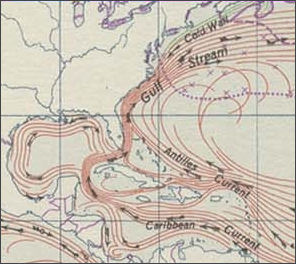
Gulf Stream“That's what scientists believe is happening now as ice in the Arctic, in places like Greenland, melts at an accelerating pace due to human-caused climate change. Recently scientists have noticed a cold blob, also known as the North Atlantic warming hole, in a patch of the North Atlantic around southern Greenland — one of the only places that's actually cooling on the planet. The fact that climate models predicted this lends more evidence that it is indicative of excess Greenland ice melting, more rainfall and a consequent slowdown of heat transport northward from the tropics.
“In order to ascertain just how unprecedented the recent slowing of the AMOC is, the research team compiled proxy data taken mainly from nature's archives like ocean sediments and ice cores, reaching back over 1,000 years. This helped them reconstruct the flow history of the AMOC. The team used a combination of three different types of data to obtain information about the history of the ocean currents: temperature patterns in the Atlantic Ocean, subsurface water mass properties, and deep-sea sediment grain sizes, dating back 1,600 years.
“While each individual piece of proxy data is not a perfect representation of the AMOC evolution, the combination of them revealed a robust picture of the overturning circulation, says lead author of the paper, Dr. Levke Caesar, a climate physicist at Maynooth University in Ireland. “The study results suggest that it has been relatively stable until the late 19th century," explains Stefan Rahmstorf from the Potsdam Institute for Climate Impact Research in Germany.
“The first significant change in their records of ocean circulation happened in the mid 1800s, after a well-known regional cooling period called the Little Ice Age, which spanned from the 1400s to the 1800s. During this time, colder temperatures frequently froze rivers across Europe and destroyed crops. “With the end of the Little Ice Age in about 1850, the ocean currents began to decline, with a second, more drastic decline following since the mid-20th century," said Rahmstorf. That second decline in recent decades was likely due to global warming from the burning and emissions of fossil fuel pollution. Nine of the 11 data-sets used in the study showed that the 20th century AMOC weakening is statistically significant, which provides evidence that the slowdown is unprecedented in the modern era.
Impact of Climate Change on Plants
An IPCC report on climate change warns of an “increased risk of extinction to 20 to 30 percent of the plant and animal species.” Some scientists predict that increased warming may cause an “evolution explosion: as species adapt to changes. Species that will do the best are those that live and die quickly and can adjust to changes while those with long life spans that can’t adjust will suffer the most.”
Scientist predict tree species will produce foliage earlier, birds will change their migration patterns and distribution of insects in certain areas will change as a result of climate change. In the past plants and animals have adapted to climate change, but some scientists worry that climate change is now occurring so fast that plants and animals will not be able to adapt — plus the places they can migrate to are limited by human occupation — there is a strong possibility some will go extinct. There is some evidence that some animals are developing genetic modifications for things such as living with longer summers that are passed on to offspring.
Many plants flower a week earlier in Europe than they did 50 years and shed their leaves five days earlier. A study by scientist at the University of Arizona of tree species and desert plants in the mountains of southern California that the plants there had moved up an elevations of 60 meters over the last 30 years.
Impact of Climate Change on Animals
There have already been reports of giant squid migrating north of their traditional ranges and devouring masses of anchovies, butterflies going extinct and flying foxes dropping dead from trees in Australia because of discase connected to 42 degree C heat. Plants and animals are expanding their ranges to higher latitudes and higher elevations. In California, species of mice are being found at elevations up 1000 meters higher in the mountains than they were 100 years ago.
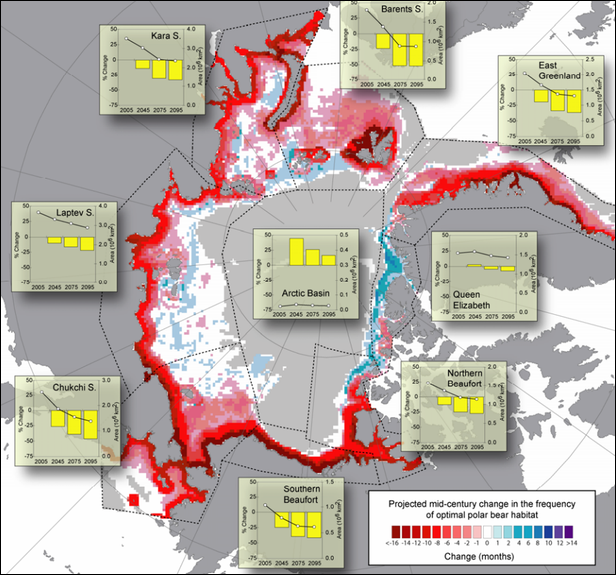
Polar Bear Habitat
Migrations patterns and ranges have been altered. Beetles are ravaging forests in northern latitudes that were once too cold for them. In Latin American, frogs and other amphibians are dying off as a result of a fungus linked with climate change. In Canada, red foxes are migrating northwards and invading territory traditionally belonging to Arctic foxes. Other species that have been affected include polar bears, gelada baboons, pygmy possums and monarch butterflies.
The ranges of many butterflies have shifted. A study of 35 nonmigratory butterfly species in Europe found that two-thirds have expanded their ranges northward by 20 to 150 miles. These changes have been noticed for some time. In early 1990s it was observed that Edith’s checkerspot butterfly was becoming more common in higher elevation and northern latitudes. Some insect migrations can have harmful consequences. Destructive bark beetles are invading forests further north than they have ever been before.
If one animal or plant is disturbed it could have an affect on others. Populations of pied flycatchers, for example, a bird that nests in Europe and winters in Africa, are shrinking because caterpillars that parents traditionally fed to their young are appearing earlier because of warming temperatures and past their peak in numbers when the flycatchers fed them to their young. Fewer young birds are surviving because they don’t get enough to eat.
Though animals can migrate and make other adaptions to climate change they often move too slowly, and lag behind the shifts in climate. Chris Thomas, a professor of Conservation Biology at the University of York, is experimenting with relocating butterfly colonies in Britain, moving them to cooler habitats, to keep them abreast with changes in climate. The colonies so far are doing well in areas 65 kilometers north of the northern limit of their ranges. The scheme — known as assisted colonization — may not work so well with animals adapted to a specific habitat that is not found further north of their range. Assisted colonization is costly. Many scientists are calling for the creation of green corridors to allow animals to migrate northward on their own. But that is no easy feat either with many roads, houses and developments lying in the way of potential green corridors.
In January 2006, Alan Ponds of the Monteverde Cloud Forest Preserve and Tropical Science Center in Costa Rica authored a study published in Nature that showed a link between frog deaths from chytridiomycosis fungus and climate change. The study focused on the disappearance of 70 species of harlequin frog in Central and South America. “Disease is the bullet killing frogs, but climate change is pulling the trigger,” Pounds said. The fugus it seems grows well under cool day time conditions and hot nighttime ones. In rainforests climate change might actually cause a cooling trend in the day as more clouds might be generated by a warming affect. More clouds could cause higher temperatures at night as the cloud keep warm air from escaping into space. The chytridiomycosis fungus grows better under these conditions.
See Separate Article POLAR BEARS, HUMANS AND GLOBAL WARMING factsanddetails.com
Animals Shrinking Because of Climate Change?
Seth Borenstein, of AP wrote, “From the mighty polar bear to the tiny house sparrow, many of Earth’s species appear to be shrinking in size, a new study reports. And the authors think it’s probably due to climate change, a little like wool sweaters that shrink when washed in hot water. But other experts say that conclusion goes too far, blaming climate change for what may be natural changes. The new research was published online in the journal Nature Climate Change. It’s based on a review of other studies and found that 38 of 85 animal and plant species showed a documented reduction in size over decades, including a type of Scottish sheep that is 5 percent smaller than in 1985. Those studies looked at species over different time periods and in varying numbers. [Source: Seth Borenstein, AP, October 23, 2011]
The shrinking victims, according to the study, include cotton, corn, strawberries, bay scallops, shrimp, crayfish, carp, Atlantic salmon, herring, frogs, toads, iguanas, hooded robins, red-billed gulls, California squirrels, lynx and wood rats. In 2009, Scottish researchers made news with the shrinking sheep study. Several studies have shown that polar bears, which rely on sea ice during the summer, also are not as big. And this latest study said the house sparrow’s weight has dropped by one-seventh from 1950 to 1990. A bird called the graceful warbler showed a 26 percent weight drop during the same time period.
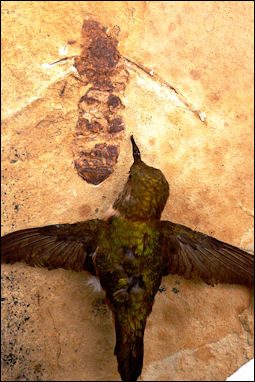
“There is a trend in a number of organisms across the board from plants to big vertebrates getting smaller,” said study co-author Jennifer Sheridan, a biology researcher at the University of Alabama. “The theory is as things get warmer they don’t need to grow as large.” Most of these animals are cold-blooded so the warmer the weather, the faster their metabolism is and the more calories they burn, Sheridan said. There’s a biological law, called Bergmann’s rule, that says that as it gets colder, animals get bigger. This is the unwritten flip side of it, she said.
But Yoram Yom-Tov, a zoologist at Tel Aviv University whose studies Sheridan used in her research, said many species are shrinking, and you can’t blame climate change exclusively. “Changes in body size are a normal phenomenon,” Yom-Tov wrote told AP. “When conditions are favorable, they increase in size or reproduce at higher rates, and when conditions are deteriorating, they do the opposite. I think that most species will adapt to climate change and survive. No need for alarm.” And Stanford biologist Terry Root, an expert in climate change, said the study’s conclusions “seem kind of far-fetched.”
Birds and Climate Change
According to research by a team lead by Victor Devictor, a researcher at the French National Museum of Natural History found that the habitats of wild bird species are shifting in response to climate change but not fast enough to stay ahead do rising temperatures. The study found that the geographic range of 105 bird species in France — accounted for 99.5 percent of the country’s wild birds — had shifted an average of 91 kilometers north between 1989 and 2006. The evidence was based on observations of birds by ornithologists and amateur birders at different times in 1,500 well-defined plots starting in 1989.
There have a number of observations of individual species shifting northward. What was particularly startling about the French study was that virtually all the bird species studied moved northward, “The response is faster than we thought but it is still not fast enough to keep up with climate change.”
North American tree swallows lay their eggs an average of nine days earlier in the early 1990s than they did in the 1950s. In Britain birds are breeding earlier than they did 50 years ago and frogs mate up to seven weeks earlier than they did in the mid 20th century.
Perhaps the worst consequence of global change for birds is that timing of their birds and their insect prey is getting out of sync. “The flora and fauna around us are shifting over time due to climate change,” Devictor told AFP. The result is desynchronisation. If birds and the insects upon which they depends do not react in the same way, we are headed for an upheaval in the interaction between species.”
A study by Stephen Willis of Durham University in Britain found that climate change is causing migrating birds to migrate further as their breeding grounds shift northward. His team that found that some types of warblers have to add 400 kilometers onto a already exhausting trips up to 6,000 kilometers to and from Africa. “For some bird the extra distance might make the difference between being able it make it or not. The study was published April 2009 in the Journal of Biogeography.
Water Shortages, Deserts and Climate Change

Empty Quarter of Arabia The World Meteorological Organization regards drinking water shortages as among the primary obstacles to sustainable development. Currently one third of humanity experiences permanent water shortages. Two thirds may experience the problem if population and climate change trends continue.
Global warming may be causing extended droughts in already arid reasons. It could d change deserts into grasslands and visa versa. An increasing number of sandstorms around the world are linked with global change and are blamed for spreading deserts and making them bigger.
The shortage of water is a big problem in many cities. Water is sometimes turned on only a couple of times a day for about a half hour each time. People with money have special storage tanks to collect water during those times, which in turn allows them to have water around the clock. People without storage tanks collect water in jugs and buckets and often have to take bucket baths when the water is not turned on.
See Separate Article WATER SHORTAGES: SOLUTIONS AND INNOVATIONS factsanddetails.com
Climate Change Impacts on Growing Coffee, Cashews and Avocados
Aryn Baker wrote in Time: “Scientists at the Zurich University of Applied Sciences in Switzerland found that the ideal regions for growing coffee, cashews and avocados will either disappear, shrink or shift as global temperatures continue to rise. The future of coffee is pretty dim, at least if you are a fan of the more refined arabica beans. But avocado lovers in today’s cooler climes could find that by 2050, their favorite toast topping is a local product instead of an import. And cashews could become a cash crop for farmers in a wider range of countries. [Source: Aryn Baker, Time, January 27, 2022]
“By looking at the ideal growing conditions for each crop, including soil quality, rainfall and temperature ranges, the scientists were able to map the locations where those conditions are currently met. They then projected the local impacts of climate change in 2050 on three different emissions scenarios: meeting the Paris Agreement goal of less than 2°C warming since pre-industrial levels; reaching 2.5°C of warming; and our current trajectory with no emissions cuts.
“In all three scenarios, coffee arabica trees fared badly, losing up to 50 percent of suitable growing areas in the major producing countries of Brazil, Vietnam, Indonesia, and Colombia, which account for 64 percent of global production. Other countries that are already growing coffee could increase production, but conditions there are equally expected to decline, however they were not a focus of the study. “Your coffee is at risk,” says lead author and environmental scientist Roman Grüter. “I wouldn’t say there might be no coffee anymore, but adapting to changing conditions will be necessary.”
“Suitable areas for avocado plantations could see declines in today’s major producers, such as Mexico, the Dominican Republic, Peru, and Indonesia (together accounting for 58 percent of the global production); whereas the United States, Argentina, China, and East Africa could offer ideal growing conditions for both cashews and avocados as those higher latitudes warm up. But, the study cautions, warming temperatures alone are not enough. A changing climate in the potential new growing regions could mean a decrease in the rainfall avocados need, or conversely, too much rain for desert-loving cashews.
“Meanwhile farmers in areas that can no longer grow those crops, such as in Colombia, will be the most affected. Avocados, cashews, and coffee may seem like a strange combination, agrees Grüter, but they were chosen for the fact that they are important cash crops for small scale farmers around the world. “They’re not only important for consumers, but also for smallholder farmers whose livelihoods depend on growing these crops in many places around the world.” They are all tree crops with long lifespans, representing a significant investment of time and land for farmers that will have a hard time adapting to changing climates.
“It’s unlikely that the crops will all fail at once, says Grüter. Instead, the impacted farmers will experience a slow decline in yield, or an increase in disease. “Cultivating crops in [climate affected] regions might get more difficult, and it will need more effort to grow the crop and then at some point, it might just not be [profitable] anymore.”
“Climate adaptation will be necessary, the report concludes. That could mean shifting the plantations to higher, cooler elevations where possible, enriching soils, implementing irrigation strategies or breeding drought and heat tolerant crops. But doing so is expensive, especially for small growers who live from one harvest to the next. “They really need alternative [crops],” says Grüter. “The responsibility is not only with [the farmer]. The regions’ agricultural consultants have to think ahead. It’s really important in agriculture today to not only anticipate consumer demands, but also changing climatic conditions.” It’s not just coffee that’s under threat, but the people who grow it too.
Image Sources: World Meteorological Organization; National Oceanic and Atmospheric Administration (NOAA), Wikimedia Commons
Text Sources: World Meteorological Organization; National Oceanic and Atmospheric Administration (NOAA), New York Times, Washington Post, Los Angeles Times, Times of London, Yomiuri Shimbun, The Guardian, National Geographic, The New Yorker, Time, Newsweek, Reuters, AP, Lonely Planet Guides, Compton’s Encyclopedia and various books and other publications.
Last updated April 2022
